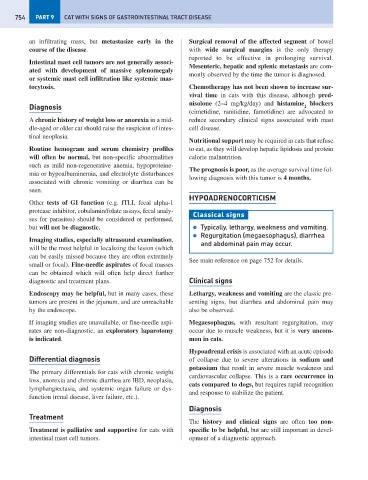Page 762 - Problem-Based Feline Medicine
P. 762
754 PART 9 CAT WITH SIGNS OF GASTROINTESTINAL TRACT DISEASE
an infiltrating mass, but metastasize early in the Surgical removal of the affected segment of bowel
course of the disease. with wide surgical margins is the only therapy
reported to be effective in prolonging survival.
Intestinal mast cell tumors are not generally associ-
Mesenteric, hepatic and splenic metastasis are com-
ated with development of massive splenomegaly
monly observed by the time the tumor is diagnosed.
or systemic mast cell infiltration like systemic mas-
tocytosis. Chemotherapy has not been shown to increase sur-
vival time in cats with this disease, although pred-
nisolone (2–4 mg/kg/day) and histamine blockers
Diagnosis 2
(cimetidine, ranitidine, famotidine) are advocated to
A chronic history of weight loss or anorexia in a mid- reduce secondary clinical signs associated with mast
dle-aged or older cat should raise the suspicion of intes- cell disease.
tinal neoplasia.
Nutritional support may be required in cats that refuse
Routine hemogram and serum chemistry profiles to eat, as they will develop hepatic lipidosis and protein
will often be normal, but non-specific abnormalities calorie malnutrition.
such as mild non-regenerative anemia, hypoproteine-
The prognosis is poor, as the average survival time fol-
mia or hypoalbuminemia, and electrolyte disturbances
lowing diagnosis with this tumor is 4 months.
associated with chronic vomiting or diarrhea can be
seen.
HYPOADRENOCORTICISM
Other tests of GI function (e.g. fTLI, fecal alpha-1
protease inhibitor, cobalamin/folate assays, fecal analy-
Classical signs
ses for parasites) should be considered or performed,
but will not be diagnostic. ● Typically, lethargy, weakness and vomiting.
● Regurgitation (megaesophagus), diarrhea
Imaging studies, especially ultrasound examination,
and abdominal pain may occur.
will be the most helpful in localizing the lesion (which
can be easily missed because they are often extremely
See main reference on page 752 for details.
small or focal). Fine-needle aspirates of focal masses
can be obtained which will often help direct further
diagnostic and treatment plans. Clinical signs
Endoscopy may be helpful, but in many cases, these Lethargy, weakness and vomiting are the classic pre-
tumors are present in the jejunum, and are unreachable senting signs, but diarrhea and abdominal pain may
by the endoscope. also be observed.
If imaging studies are unavailable, or fine-needle aspi- Megaesophagus, with resultant regurgitation, may
rates are non-diagnostic, an exploratory laparotomy occur due to muscle weakness, but it is very uncom-
is indicated. mon in cats.
Hypoadrenal crisis is associated with an acute episode
Differential diagnosis of collapse due to severe alterations in sodium and
potassium that result in severe muscle weakness and
The primary differentials for cats with chronic weight
cardiovascular collapse. This is a rare occurrence in
loss, anorexia and chronic diarrhea are IBD, neoplasia,
cats compared to dogs, but requires rapid recognition
lymphangiectasia, and systemic organ failure or dys-
and response to stabilize the patient.
function (renal disease, liver failure, etc.).
Diagnosis
Treatment
The history and clinical signs are often too non-
Treatment is palliative and supportive for cats with specific to be helpful, but are still important in devel-
intestinal mast cell tumors. opment of a diagnostic approach.

